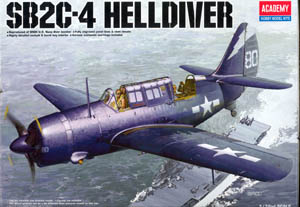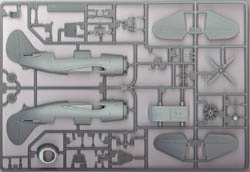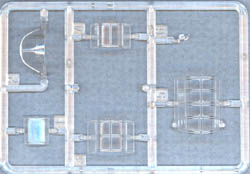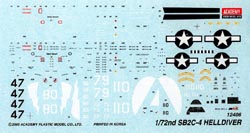Academy 1/72 SB2C-4 Helldiver
|
 |
History
The SB2C Helldiver probably would have to rank pretty high on any 'most
maligned' aircraft list. Yet, in spite of a very rocky start, the "Beast"
went on to become a significant contributor to the later stages of the
U.S. Navy's carrier campaign in the Second World War.
To list or write about all the problems and tribulations, bumps and
ditches, bad management and just plain unfortunate happenings that plagued
this aircraft's development would take far more space than we have here,
but one would have to wonder how much it contributed to Curtiss' eventual
sale to North American shortly after WWII.
It all started in 1938 with the decision by the Navy to seek a replacement
for the SBD Dauntless dive bomber. They wanted something bigger and more
powerful, with folding wings and a power operated turret. This last item,
the turret, would be one of the significant stumbling blocks for Curtiss.
They never really were able to develop a satisfactory one and eventually
the Navy agreed to drop the requirement. If all this wasn't sporty enough,
the only engine capable of providing enough horses was the yet to even
run Wright R-2600. The development of the engine was as troublesome as
the airframe.
The specifications outlined by the Navy were imposing for the time.
In addition to the above requirements they wanted a range of 1,000 miles
carrying a 1,000 pound bomb load in an internal bomb bay, and all of
this in an airframe that would fit on the then current carrier elevators.
And they wanted TWO of them on the elevator at the same time! To understand
the significance of these requirements we need to understand that the
then current carriers were still operating biplanes such as the SBC Helldiver
and F3F Grumman fighters.
 Right
from the get go it was obvious that this was going to be a big, heavy
and imposing airplane. What was even more obvious to the various aircraft
manufacturers that received the request for bid was the fact that it was
going to be almost impossible to get everything the Navy wanted into an
airframe that might even fly. As a result, only Brewster and Curtiss submitted
bids. Both were awarded contracts, and both had significant problems to
the extent that the Brewster XSB2A never reached combat. Right
from the get go it was obvious that this was going to be a big, heavy
and imposing airplane. What was even more obvious to the various aircraft
manufacturers that received the request for bid was the fact that it was
going to be almost impossible to get everything the Navy wanted into an
airframe that might even fly. As a result, only Brewster and Curtiss submitted
bids. Both were awarded contracts, and both had significant problems to
the extent that the Brewster XSB2A never reached combat.
The Helldiver finally reached combat in late 1943, and went on to serve
in most of the late war operations in both the Atlantic and Pacific.
The Army Air Corps, the British and the Australians all initially showed
interest in the Helldiver, but due to delays and performance problems
all decided to not proceed.
Despite all the development difficulties, by the end of the war the
Helldiver had proved to be a rugged and dependable contributor to the
carrier striking force. It went on to be a major part of the post war
reserve fleet, finally leaving U.S. Navy service in 1948.
Greece, Italy Portugal, Thailand and France all used the SB2C-5 version.
Greece put their birds to work against the Communist expansion and insurgency
threat and finally retired the last one in 1953.
The French used theirs in their long and difficult war in Indo-China,
and finally retired their last bird in 1952.
The Italians managed to keep their Helldivers out of any wars, and operated
them until 1959.
Portugal obtained twenty four Helldivers and they flew them from 1950
until retirement in 1956. Thailand only operated six and they were gone
by 1957.
The Kit
 OK, so what has Academy done with this thing? There are two sprues of
the usual medium Gray plastic and the single one of clear parts. No flash,
no flaws, nothing but just very nicely detailed parts. The first positive
impressions that caught my eye were the rocket stubs molded right on
the bottom of the wings, very nicely done scribing everywhere, structural
details on the inside of doors and a lot of interior parts and details.
This last one is important because all the greenhouse glass makes a good
interior very important on this bird. Not much room or need for any aftermarket
interior here. Academy has given you about everything that could be seen. OK, so what has Academy done with this thing? There are two sprues of
the usual medium Gray plastic and the single one of clear parts. No flash,
no flaws, nothing but just very nicely detailed parts. The first positive
impressions that caught my eye were the rocket stubs molded right on
the bottom of the wings, very nicely done scribing everywhere, structural
details on the inside of doors and a lot of interior parts and details.
This last one is important because all the greenhouse glass makes a good
interior very important on this bird. Not much room or need for any aftermarket
interior here. Academy has given you about everything that could be seen.
Other points worth noting are some of the smaller stuff that shows Academy
did their homework. Fabric on just the undersides of the ailerons, open
slats on the outboard leading edges, and a very complete bomb bay interior.
The ceiling of the bomb bay part is accurately curved to represent the
top wing surface and also accurately serves as the cockpit floor. One
other nice touch is the four bladed prop has a separate spinner. Getting
to a post war SB2C-5 would be a major chore, but at least the prop would
help.
Negatives? Not many but a couple of significant ones for me. The biggest
may be the open bomb bay. If you only want one Helldiver, then the open
and well detailed one in this kit might be just what you want, but should
you desire to do several models of the Beast in different markings, then
the always open bay is a bit of a pain. The doors are molded integral
with the bomb bay sides, so it might be a challenge to figure out how
to cut them off and make them fit.
 The
second major disappointment for me was the lack of any provision for the
open dive brakes. Academy did a very good job of scribing in the very
complex hole pattern for the closed dive brakes, but for me a big part
of the Helldiver's appeal are the huge and very impressive flaps and upper
dive brakes. To be fair, I realize that it was not likely Academy was
going to go to the extra expense of providing what probably would have
to have been a rather large etched metal sheet for open dive brakes, but
what a difference it would have made! I hope Eduard or someone takes on
the challenge. The
second major disappointment for me was the lack of any provision for the
open dive brakes. Academy did a very good job of scribing in the very
complex hole pattern for the closed dive brakes, but for me a big part
of the Helldiver's appeal are the huge and very impressive flaps and upper
dive brakes. To be fair, I realize that it was not likely Academy was
going to go to the extra expense of providing what probably would have
to have been a rather large etched metal sheet for open dive brakes, but
what a difference it would have made! I hope Eduard or someone takes on
the challenge.
Another "I wish" thing is the rear gunner's cockpit. They
made no provision for the interesting accordion fold turtle deck to fold
down to expose the rear guns. Again, probably not a big deal, but another
one of the signature items for the Helldiver.
Another minor gripe is the top scoop in the front of the engine cowling
is just an indent. It would have looked better as an open scoop.
The assembly instructions are a welcome departure from the usual line
drawings. This time they used very well done shadowed and highlighted
assembly drawings that are much improved over what we are used to seeing.
The relationship of parts and where things actually go just seems clearer
and easier to understand.
 The markings choices are two all Sea Blue birds from the USS Shangri-La,
a single three tone camouflage one from the Yorktown, and a very welcome
Sea Search white and Gray Atlantic bird. The decal sheet is very well
done, and includes a lot of stencil and maint. markings as well as welcome
stuff like wing walks and even the yellow stripes for the two bombs. The markings choices are two all Sea Blue birds from the USS Shangri-La,
a single three tone camouflage one from the Yorktown, and a very welcome
Sea Search white and Gray Atlantic bird. The decal sheet is very well
done, and includes a lot of stencil and maint. markings as well as welcome
stuff like wing walks and even the yellow stripes for the two bombs.
The clear parts are notably clear, thin, and in sections so you can
open some parts. Masking all the frames will be fun.
Conclusions
This is another beautiful Academy effort. The negatives I mentioned
above are clearly personal choices of things I would have liked to see.
They in no way should be considered flaws. What you will get is in my
opinion the definitive Helldiver kit in 1/72nd. The Helldiver is probably
the last of the major U.S. Navy World War Two carrier birds to be well
done in 1/72nd.
Our thanks to MRC for providing the review sample.
|
|
